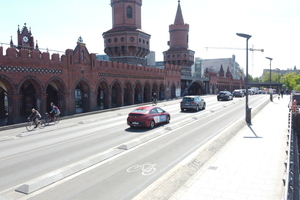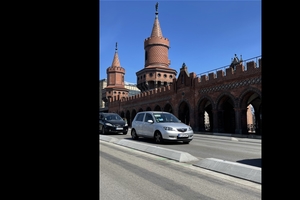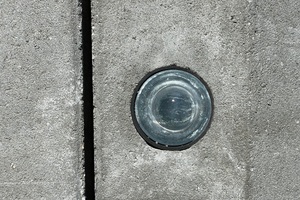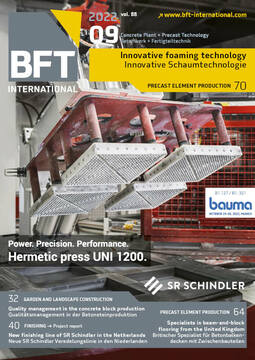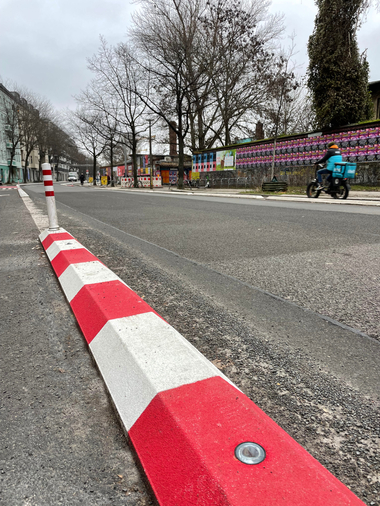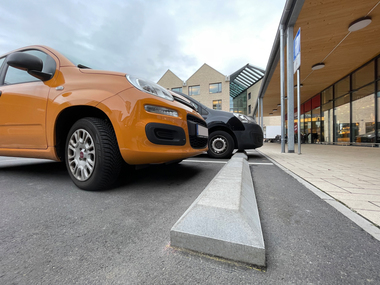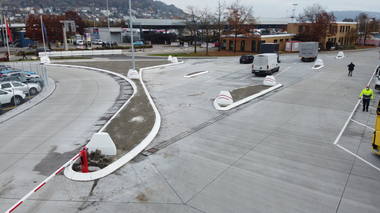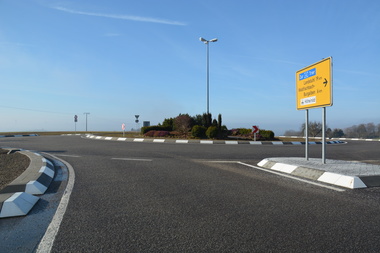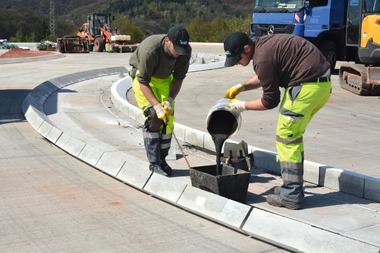Roadway dividers of glued curbstones on the Oberbaum Bridge in Berlin
When Berliners talk about “the most beautiful bridge in the capital,” they most often mention the Oberbaum Bridge in the district of Friedrichshain-Kreuzberg. The structure connects the two municipal districts across the Spree River. From 1961 to 1989, the bridge divided the city and became a border-crossing point. The distinguishing feature of the bridge, built in 1723 by royal order, are the spires of various designs, ornamented with reliefs of Berliner bears and the Brandenburg eagle. According to counts, the bridge is one of the most heavily frequented places by bicycle traffic in Berlin. To prevent accidents, the two cycle lanes across the bridge were provided in the spring of 2022 with road dividers consisting of glued curbstones.
The roadway on Oberbaum Bridge had been completely overhauled already in early 2019. The Berlin Senate Administration for Environment, Transport and Climate Protection had specified that the bicycle paths on both sides were to have a width of two meters. However, when construction work on the bridge was completed, it was found that the new bicycle lanes had a width of only 1.85 m and were therefore too narrow for safe overtaking. In addition, they were not physically separated from automobile traffic, which is a violation of the mobility law.
No illegal intrusion by automobiles
The planners decided to provide the already existing bicycle paths over a length of approx. 950 m with structural protection in the form of glued concrete curbstones to guard them from illegal intrusion by automobiles. Andreas Woyack, Project Manager with the construction contractor Matthäi Bauunternehmen GmbH & Co. KG from Berlin, provides more details: “Two lanes exist on the bridge in each direction of travel: one for bicycles and one for automobiles. Between these two lanes there is a safety separation strip which until now was marked with a wide and a narrow strip of cold plastic. What was needed here was a solution that would it make impossible for vehicles to intrude into the bicycle lane.”
“Concrete curbstones were the suitable solution here. The surfacing over the entire roadway to be modified was asphalt. We decided on the adhesive bonding technique for the curbstones,” explains Woyack. The roadway divider was created from flat curbstones of grey concrete, uniformly cut to a cross-section of 30 x 17 (F15). The curbstones were delivered by the concrete plant Betonwerk Hermann Meudt in Wallmerod, Germany. The curbstones were then glued back-to-back with 2-component methacrylate mortar of type Silikal R17, without milling, so that the area to be protected between the wide and the narrow strips was filled. The bottom sides of the curbstones as well as the asphalt surface layer had first been prepared with a 2-component Silkal R51 synthetic resin layer.
Better night visibility
To improve the night visibility of the system, the construction contractor Matthäi used core drilling to install 360 ° glass markers into the curbstones at regular intervals on the side facing automobile traffic. To enable drainage, an area of 0.5-m length was kept free every five meters. One segment thus consists of two corner blocks 30 x 15 x 50 cm und eight flat blocks FB 30 x 25 x 50, cut to the height of 17 cm.
Andreas Woyack notes in conclusion: “The curbstone adhesive bonding technique from the concrete plant Hermann Meudt was a very good solution here. We are entirely confident that cyclists can from now on cross the bridge much more safely.”
CONTACT
Hermann Meudt Betonsteinwerk GmbH
Frankfurter Straße 38
56414 Wallmerod/Germany
+49 6435 50920

